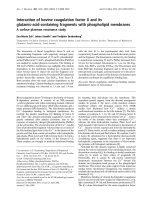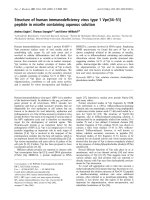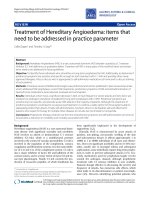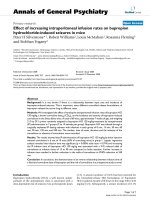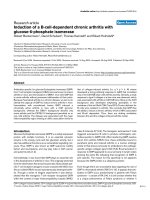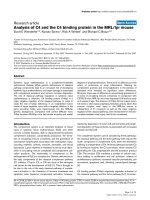Báo cáo y học: "Deletion of 1.8-kb mRNA of Marek’s disease virus decreases its replication ability but not oncogenicity" ppt
Bạn đang xem bản rút gọn của tài liệu. Xem và tải ngay bản đầy đủ của tài liệu tại đây (385.86 KB, 7 trang )
RESEARC H Open Access
Deletion of 1.8-kb mRNA of Marek’sdiseasevirus
decreases its replication ability but n ot oncogenicity
Aijun Sun
1†
, Yanpeng Li
2†
, Jingyan Wang
1
, Shuai Su
1
, Hongjun Chen
3
, Hongfei Zhu
2
, Jiabo Ding
4*
, Zhizhong Cui
1*
Abstract
Background: The 1.8-kb mRNA was reported as one of the oncogenesis-related genes of Marek ’s disease virus
(MDV). In this study, the bacterial artificial chromosome (BAC) clone of a MDV field strain GX0101 was used as the
platform to generate mutant MDV to examine the functional roles of 1.8-kb mRNA.
Results: Based on the BAC clone of GX0101, the 1.8-kb mRNA deletion mutant GX0101Δ(A+C) was constructed.
The present experiments indicated that GX0101Δ(A+C) retained a low level of oncogenicity, and it showed a
decreased replication capacity in vitro and in vivo when compared with its pa rent virus, GX0101. Further studies in
vitro demonstrated that deletion of 1.8-kb mRNA significantly decreased the transcriptional activity of the bi-
directional promoter between 1.8-kb mRNA and pp38 genes of MDV.
Conclusion: These results suggested that the 1.8-kb mRNA did not directly influence the oncogenesis but related
to the replication abilit y of MDV.
Background
Marek’s disease (MD) is a contagious lymphoprolifera-
tive disease of poultry caused by the highly oncogenic
alphaherpesvirus, MDV, which is characteristic by
mononuclear infiltration of peripheral nerves, irises, skin
and other visceral tissues [1,2]. Among the 100 genes
encoded by MDV, three genes including 1.8-kb mRNA,
pp38 and meq were considered to be associated with
oncogenicity of MDV serotype 1, and they are also
unique to MDV [3,4] . Previous studies suggested that
meq is invol ved in lymphocyte transformation [5,6], and
pp38 is involved in early cyto lytic infection in lympho-
cytes but not in the induction of tumors [7]. In addition,
recent studies indicated that pp38 could also enhance
the activity of the bi-directional promoter, which locates
between pp38 and 1.8-kb mRNA in the long inverted
repeat region of the viral genome, thus influence the
replication capacity of the virus [8-10].
The1.8-kbmRNAisuniquetoMDVandithasno
homology with other groups of herpesviruses, and it
received attention as a pathogenic determinant following
demonstration of the expansion of the 132-bp tandem
repeats in the 1.8-kb mRNA regio n during attenuation of
MDV. However, deletion of the two copies of the 132-bp
repeat region in a pathogenic MDV demonstrated that
the virus was still pathogenic [11]. The transcription map
of 1.8-kb mRNA was published in 1989 [12], analysis of
cDNA in the 1.8-kb mRNA region identified two main
open reading frames (ORFs) (ORF A and ORF C), and
the proteins encoded by ORF A and C could be detected
in chicken embryo fibroblasts (CEF) infected with very
virulent MDV as well as MDV-induced lymphoid cell
lines [13]. Therefore, in the present study, ORF A and C
were selected as the targets to study.
Recent progresses in BAC cloning and mutagenesis
technology make it possible to identify specific genes
important for MDV replication and oncogenesis. In ear-
lier studies we cloned the full length genome of a viru-
lent MDV strai n, GX0101, into a bacterial artificial
chromosome (BAC) and reconstituted the infectious
virus, bac-GX0101. Studies in specific-pathogen-free
(SPF) chickens showed that the virulence of bac-
GX0101 was higher than virulent MDV (vMDV) GA
strain but lower than very virulent MDV (vvMDV)
strain Md5, and there was no difference in growth abil-
ity and pathogenicity to birds when compared with its
parental virus, GX0101 [14-16]. In this study, the BAC
* Correspondence: ;
† Contributed equally
1
Animal Science and Technology College, Shandong Agricultural University,
Tai’an, Shandong 271018, China
4
China Institute of Veterinary Drug Control, Beijing 100081, China
Full list of author information is available at the end of the article
Sun et al. Virology Journal 2010, 7:294
/>© 2010 Sun et al; licensee BioMed Central Ltd. This is an Open Access article distributed under the terms of the Creative Commons
Attribution License (http://creativecommons .org/licenses/by/2.0), which permits unrestricted use, distribution, and reproduction in
any medium, provided the original work is properly cited.
clone of GX0101 was used as the platform to generate
mutant MDV to examine the functional roles of 1.8-kb
mRNA.
Results
Verification of GX0101Δ(A+C)
The deletion of the ORF(A+C) was confirmed by PCR
with purified GX0101Δ1(A+C)-BAC and GX0101Δ(A+C)-
BAC as templates [16]. As shown in Figure 1, the deletion
of both copies of ORF(A+C) was confirmed by agarose gel
electrophoresis of PCR. Then the GX0101Δ(A+C)-BAC
DNA was transfected into CEF for the rescue of GX0101Δ
(A+C) virus. As shown in Figure 2, the plaque size of
GX0101Δ(A+C) was smaller than that of GX0101 at 96 h
after infected in fresh CEF cells.
In vitro replication of GX0101Δ(A+C)
To determine whether the deletion of the 1.8-kb mRNA
had any effect on GX0101Δ(A+C) growth replication i n
vitro, the growth rate of GX0101Δ(A+C) virus was com-
pared with that of GX0101. As shown in Figure 3, it
was demonstrated that the r ecombinant virus GX0101Δ
(A+C) exhibited a decr eased replication ability in CEF
compared with GX0101 at hours 7 2, 96, 120 and 14 4
post inoculation (p.i.) (P < 0.05).
Viremia levels of birds infected with GX0101Δ(A+C) or
GX0101 viruses
The viremia levels in 10 birds from each group were
determined on days 7, 14, 21 and 28 p.i. As indicated in
Table1,theviremialevelsofGX0101Δ(A+C) -infected
group were lower than that of GX0101 group during
the whole experimental period, and signif icant differ-
ences were observed between the t wo groups on days
14, 21 and 28 p.i. (P < 0.05).
The effect of ORF (A+C) on the activity of bi-directional
promoter
To determinate the activity of the bi-direc tional promo-
ter, plasmids pP(pp38)-CAT and pP(1.8-kb)-CAT were
used to transfect CEF monolayers. The results showed
that the CAT expression leve l in uninfecte d CEF was
very low, nearly 0. The CAT activity in GX0101-CEF
was higher than that in GX0101Δ(A+C)-CEF (P < 0.05)
(Table 2). The results indicated that 1.8-kb mRNA sig-
nificantly affected the activity of the bi-directional
promoter.
Pathogenicity of GX0101Δ(A+C) and GX0101
To compare the pathogenicity of mutant virus with its
parental virus, we examined the growth rates of infected
birds. Both viruses strongly inhibited the growth rates of
infected birds. As shown in Table 3, body weights of the
birds inoculated with GX0101 Δ(A+C) and GX0101 were
significantly lower (P < 0.05) than that of control birds
from 5 weeks p.i. Between the two viruses, GX0101
showed stronger effects on growth rates of birds tha n
GX0101Δ(A+C) although the difference was not statisti-
cally significant (P > 0.05).
During 120 days after challenged with the two viruses,
50% and 40% mortality were observed in groups inocu-
lated with G X0101 or GX0101Δ( A+C), respectively.
Furthermore, 22.5% and 12.5% of birds exhibited visceral
Figure 1 Analysis of PCR products of GX0101Δ(A+C)-BAC DNA.
Lane M: DL2000 marker (TaKaRa Bio-Company, China); 1: the PCR
product of GX0101Δ1 (A+C); 2: the PCR product of GX0101Δ (A+C).
The bigger band demonstrated one of ORF (A+C) was replaced by
kana gene (in lanes 1 and 2). The smaller band demonstrated the
deletion of the second ORF(A+C) in GX0101Δ(A+C)-BAC DNA (in
lane 2) compared to the smaller band that not deleted the second
ORF(A+C) in GX0101Δ1(A+C)-BAC DNA (in lane 1).
Sun et al. Virology Journal 2010, 7:294
/>Page 2 of 7
tumors conformed by histopathologic changes in different
tissues (spleen, liver, heart, and kidney) in groups infected
with GX0101 or GX0101Δ(A+C), respectively (Table 4).
And no death was observed in the control group. These
results showed that the mortality and oncogenicity of
GX0101Δ(A+C) were lower than that of GX0101,
although the difference was not significant (P > 0.05).
Immunosuppressive effects of the two viruses
As demonstrated in Table 5, hemagglutination inhibition
(HI) antibody titers to AIV-H9 in birds infected with
GX0101Δ(A+C) or GX0101 were significantly lower
than that o f the control birds (P < 0.05). Between the
two viruses, HI antibody titers to AIV-H9 in birds
infected with GX0101 were signif icantly lower than that
Figure 2 Comparison of plaque characteristic of bac-GX0101Δ(A+C) and parental virus GX0101 in CEF.A:plaqueofGX0101Δ(A+C); B:
plaque of GX0101. GX0101 and GX0101Δ(A+C) were inoculated onto six-well plates seeded with CEFs and incubated at 37°C, 5% CO
2
,
respectively. Visible viral plaques were confirmed by IFA with monoclonal antibody H19. The plaque size of GX0101Δ(A+C) was smaller than that
of GX0101 at 96 h after infected in fresh CEF cells.
Figure 3 Growth curves of GX0101Δ(A+C) and GX0101 in vitro. 100 PFU GX0101 and GX0101Δ(A+C) were inoculated onto six-well plates
seeded with 2×10
6
CEFs and incubated at 37°C, 5% CO
2
, respectively. At hours 0, 24, 48, 72, 96, 120 and 144 p.i., the infected cells were
trypsinized and serial 10-fold dilutions were added onto six-well plates of CEFs, visible viral plaques were counted on days 5 p.i. by IFA. The
means ± SD at each time point were shown, *P < 0.05 compared with those in GX0101 group. It was demonstrated that the mutant virus
GX0101Δ(A+C) exhibited a decreased replication ability in CEF compared with GX0101 at hours 72, 96, 120 and 144 p.i. (P < 0.05).
Sun et al. Virology Journal 2010, 7:294
/>Page 3 of 7
of birds infected with GX0101Δ(A+C) (P < 0.05). How-
ever, HI anti body titers to AIV-H5 and NDV, GX0101
showed stronger immunosuppressive effects than
GX0101Δ(A+C), although the difference was not statisti-
cally significant (P > 0.05).
Discussion
It was reported that CAT activity under the control of
the bi-directional promoter was only detected in MDV-
infected CEF but not in uninfected CEF when trans-
fected with CAT reporter plasmids, indicating t hat the
bi-directional promoter requires either viral or MDV-
infection related cellular factors for regulation [17]. In
the previous reports, we found that the activity of bi-
directional promoter in the direction of the 1.8-kb
mRNA was higher than t hat in the direction of the
pp38, and the CAT activity was significantly low er but
not disappeared in a pp38 deletion virus than in the
parental virus [8-10]. This suggested that pp38 plays an
important role in regulating the transcript ional activity
of the bi-directional promoter, but that an additional
factor may also be necessary. In this study, CAT gene
was used as a reporter to investigate the influence of
1.8-kb mRNA on its upstream bi-directional promoter.
The results showed that the CAT expression level of
GX0101Δ(A+C)-CEF was significantly lower than that in
GX0101-CEF transfected with two CAT reporter plas-
mids under the control of the bi-directional promo ter in
two opposite oppositions. These results suggested that
1.8-kb mRNA was necessary in addition to pp38 f or
transcriptional activity of the bi-directional promoter.
However, either pp38 or 1.8-kb mRNA did not fully
affect the promoter activity, respectively. Our future stu-
dies will focus on the construction of pp38- and 1.8-kb
mRNA-deleted virus, it may help to examine whether
the activity of the promoter will be fully removed after
both pp38 and 1.8-kb mRNA were deleted.
Following deletion of ORF (A+C), we found that the
replication ability of GX0101Δ(A+C) was decreased
compare d to that of GX010 1 in vitro and in vivo. MDV
replication origin locates between pp38 and 1.8-kb
mRNA in the lon g inverted repeat region of the viral
genome, therefore, we speculate that 1.8-kb mRNA
might affect the MDV replication origin as its effect to
the bi-directional promoter. However, furt her studies
are required to confirm this hypothesis and to under-
stand the mechanism of 1.8-kb mRNA.
Although GX0101Δ(A+C) was severely impaired for in
vivo replication, the virus retained a low level of onco-
genicityandthusdemonstratedthat1.8-kbmRNAwas
dispensable for tumor induction. Meanwhile, HI anti-
body titers to AIV-H9, AIV-H5 and NDV in birds
infected with GX0101 were lower than those infected
with GX0101Δ(A+C) (P < 0.05). The differences i n
tumor induction or immunosuppressi on effects between
GX0101Δ(A+C) and GX0101 may be due to the poor
replication ability in vivo of GX0101Δ(A+C).
Conclusion
These results suggested that the 1.8-kb mRNA gene
family did not directly influence the oncogenesis of
MDV but related to its replication abili ty. And our
future studies will concentrate on the identification of
the 1.8-kb mRNA product and its mechanism.
Methods
Virus and Plasmid
A field virulent MDV strain, named GX0101, was iso-
lated from a layer farm in Guangxi province in China
[14]. In our previous study, a full-len gth infectious BAC
clone of GX0101 strain and Escherichia coli EL250 (har-
boring the GX0101-BAC containing the whole genome
of GX0101) were constructed [15,16].
The recombinant plasmids expressing chlorampheni-
col acetyltransferase (CAT) gene under the control of
the bi-directional promoter were constructed in our
laboratory [9]. In the recombinant plasmid pP(pp38)-
CAT, CAT was expressed under the pro moter in pp38
direction, and i n the reco mbinant plasmid pP(1.8-kb)-
Table 1 Comparision of viremia levels between GX0101
and GX0101Δ(A+C) infected SPF chickens (n = 10)
Days post inoculation Viremia (PFU/ml)
GX0101 GX0101Δ(A+C)
7 156.5 ± 40.5 a 123.8 ± 27.3 a
14 475.8 ± 55a 255.0 ± 39.5 b
21 1567.4 ± 253.6 a 455.4 ± 98.7 b
28 1244.3 ± 242.6 a 513.4 ± 188.9 b
The numbers in the table indicate: mean ± standard deviation. The same
letters following values indicate that the differences were not significant (P >
0.05) between treatments at each time. The different letters following values
indicate that the differences were significant (P < 0.05) between treatments at
each time.
Table 2 Comparision of CAT expression levels under the
promoter in opposite directions in GX0101Δ(A+C)-CEF or
GX0101-CEF (n = 5)
Transfected CEF
Transfected
plasmids
GX0101Δ(A+C)-CEF GX0101-CEF CEF
pP(pp38)-
CAT
0.069 ± 0.013b 0.413 ± 0.045a 0.002 ± 0.0002c
pP(1.8-kb)-
CAT
0.073 ± 0.024b 0.505 ± 0.068a 0.001 ± 0.0004c
Control 0.000 ± 0.000a 0.000 ± 0.000a 0.000 ± 0.000a
The numbers in the table indicate: mean ± standard deviation of five replicate
assays with a given reporter plasmid. The same letters following values
indicate that the differences were not significant (P > 0.05) between
treatments. The different letters following values indicate that the differences
were significant (P < 0.05) between treatments.
Sun et al. Virology Journal 2010, 7:294
/>Page 4 of 7
CAT, CAT was expressed under the promoter in 1.8-kb
direction.
Construction of GX0101Δ(A+C)-BAC
Replacement of the ORF (A+C) with the Kan
R
gene was
carried out by a procedure of homologous recombina-
tion [16]. E lectrocompetent cells were prepared from
Escherichia coli EL250 (harboring the GX0101-BAC)
grown at 30°C in Luria-Bertani (LB) medium containing
chloramphenicol (25 mg/ml) to an optical density
(OD600) of 0.6. The expression of recE, recT, and l
gam was induced by 42°C for 15 min. Kan
R
cassette
flanked by FRT sites was amplified using primers 1.8-kb
mRNA (A+C)-kan
R
-F and 1.8-kb mRNA(A+C)-kan
R
-R
(Table 6) from pKD13 [18]. About 300 ng of the PCR
products were electroporated into 50 μlofelectrocom-
petent EL250 cells harboring the GX0101-BAC using
standard electroporation parameters (2.0 KV, 200 Ω and
25 μF), and recombinant clones were isolated and exam-
ined for insertion of kan
R
into the right locus using
PCR. Once individual clones were examined and con-
firmed to lack spurious changes, kan
R
was excised by
induction of FLP recombination by incubation in LB
medium containing 0.0 2% arabinose for 12 h. In order
to delete the second ORF(A+C) copy, the entire proce-
dure was repeated. Once both copies were deleted, an
recombinant virus, named GX0101Δ(A+C), was recon-
stituted by transfecting CEF cultures with purified BAC
DNA. And the recombinant virus, in which one copy
ORF(A+C) was deleted, named as GX0101Δ1(A+C).
Confirmation of the deletion of ORF(A+C)
The deletion of the ORF(A+C) from the GX0101 BAC
DNAwereanalyzedbyPCRusingprimers,whichcross
the 1.8-kb mRNA ORF(A+C), as follows: forward primer,
5’ -GGCTAGCATTCGATAAGC-3’ ; reverse primer,
5’ -GGAGGTGTAATATAAGG G-3’ . GX0101Δ(A+C)
was reconstituted by transfecting CEF cultures with puri-
fied BAC DNA as previously described [15]. When CEF
started to show plaques, the cells were passed by trypsini-
zation. The virus-containing cells were passed 3 to 4
rounds for enrichment of infectious clone virus
GX0101Δ(A+C). Finally, the cells infected with GX0101Δ
(A+C) were harvested and stored in liquid nitrogen.
After transfection of the mutant viruses into CEF cul-
tures , we compared the plaques of GX0101Δ(A+C) with
those of GX0101 by immunofluorescence analysis (IFA)
with monoclonal antibody H19 at 96 h after infected in
fresh CEF cells as previously described [19] with modifi-
cations. Briefly, infected cells were washed with PBS and
fixed with ethanol:acetone solution (4:6) at room tem-
perature for 10 min. After remov ing fixing solution, the
cells were air dried, and incubated with H19 (1:1000)
for 1 h at 37°C. Following three washes with PBS, the
cells were incubated with goat anti mouse FITC labeled
secondary antibodies (Sigma) for 1 h. Cells were further
washed three times with PBS and examined under a
fluorescence microscope.
In vitro and in vivo replication of GX0101Δ(A+C)
The rates of growth in vitro of GX0101Δ(A+ C) were
measured as follows, briefly, 100 PFU GX0101 and
GX0101Δ(A+C) (from stock virus in liquid nitrogen)
were inoculated onto six-well plates seeded with 2×10
6
CEFs and incubate d at 37°C, 5% CO
2
, respectively. At
hours 0, 24, 48, 72, 96, 120 and 144 p.i., the infected
Table 3 Comparisons of growth rates of birds challenged with GX0101Δ(A+C) or GX0101
Weeks post inoculation Groups
Control GX0101Δ(A+C) GX0101
3 117.91 ± 9.40 (13) a 111.62 ± 18.62 (34) a 117.88 ± 17.63 (33) a
4 189.17 ± 18.44 (13) a 175.74 ± 33.62 (34) a 174.84 ± 32.44 (31) a
5 275.42 ± 30.34 (13) a 243.24 ± 46.9 (34) b 233.83 ± 51.82 (30) b
6 401.25 ± 41.24 (13) a 335.61 ± 62.71 (33) b 309.66 ± 91.74 (29) b
8 672.92 ± 72.53 (13) a 571.72 ± 102.58 (32) b 510.19 ± 155.27 (26) b
The numbers in the table indicate: mean ± standard deviation. Different letters indicate that the differences were significant (P < 0.05) between treatments at
each time.
Table 4 Comparison of the mortality and oncogenicity in
SPF chickens
Strain Mortality (%) Oncogenicity (%)
GX0101 20/40 (50.0) 9/40 (22.5)
GX0101Δ(A+C) 16/40 (40.0) 5/40 (12.5)
Control 0/13 (0) 0/13 (0)
Table 5 Influence of GX0101Δ(A+C) and GX0101 virus
infections on HI antibody titers to NDV, AIV-H5 and AIV-
H9 after vaccination
Strain HI titers (log2)
NDV AIV-H5 AIV-H9
GX0101 9.71 ± 1.46 (28)b 4.45 ± 2.92 (28)b 3.48 ± 2.06 (28)c
GX0101Δ(A+C) 10.07 ± 1.23 (33)a 5.63 ± 2.77 (33)b 5.50 ± 2.39 (33)b
Control 10.57 ± 0.76 (13)a 7.15 ± 1.41 (13)a 7.00 ± 1.41 (13)a
The numbers in the table indicate: mean ± standard deviation. Different
letters indicate that the differences were significant (P < 0.05) between
treatments.
Sun et al. Virology Journal 2010, 7:294
/>Page 5 of 7
cells were trypsinized and serial 10-fold dilutions were
added o nto six-well plates of CEFs, visible viral plaques
were counted on days 5 p.i. by IFA.
In vivo replication of GX0101Δ(A+C) we re measured
as follows. In brief, blood samples in anticoagulants
were collected from 10 birds of each group on days 7,
14,21and28p.i.,and1mlbloodfromeachbirdwas
mixed with 9 ml DM EM. Blood suspensions were cen-
trifuged for 5 min at 500 g to separate white blood cells.
And 500 μl wh ite blood cells (10
6
cells/ml) collected
after centrifugation were used to inoculate two duplicate
35-mm plates with CEF monolayer. To determine vire-
mia leve ls, visible viral plaques were counted on days 5
p.i. by IFA.
Determination of CAT activity in GX0101-CEF and
GX0101Δ(A+C)-CEF
To analyze the transcriptional activity of the bi-direc-
tional promoter in GX0101Δ(A+C) infected CEF, plas-
mids pP(pp38)-CAT and pP(1.8-kb)-CAT were used to
transfect GX0101-CEF or GX0101Δ(A+C)-CEF, respec-
tively. Construction of recombinant plasmids expressing
CAT gene under the c ontrol of the bi-directional pro-
moter was performed as previously described [9]. Briefly,
the bi-directional promoter sequences were amplified by
PCR, and the PCR products were inserted i nto pCAT-
Basic vector (Promega) at the KpnI and SacI sites. In
the recombinant plas mids, pP(pp38)-CAT and pP(1.8-
kb)-CAT, CAT was expressed under the regulation of
the promoter in opposite directions. Transfection of
recombinant plasmid DNA was performed as previously
described, and all dishes were incubated at 37°C in a
CO
2
incubator [9]. The expression of CAT was deter-
mined 48 h after transfection. T he transfected CEF were
harvested and resuspended in 500 μl lysis buffer p er 35
mm dish, and samples were centrifuged for 5 min at
10,000 rpm. Aliquots of the supernantants were detected
with CAT ELISA Kit (Roche).
Pathogenicity of GX0101 and GX0101Δ(A+C)
One-day-old m ale SPF chickens were randomly divided
into three groups and kept in three isolators under posi-
tive filtered air. In the experiment, 40 birds were
inoculated intra -abdo minally wi th 1000 PFU of GX0101
or GX0101Δ(A+C). A control group of 13 birds was
inoculated with uninfected CEF. During 120 days after
challenge with the two viruses, all chickens were exam-
ined for gross MD lesions. Body weight measurements
of the birds in different groups were made on weeks 3,
4, 5, 6 and 8 p.i., in order to evaluate the effect of the
two viruses on chicken growth rates.
Immunosuppressive effects of the GX0101 and
GX0101Δ(A+C)
In order t o evaluate the immunos uppressive effects of
the two viruses, on one-day-old, chickens were inocu-
lated intra-abdominally with 1 ,000 PFU of GX0101 or
GX0101Δ(A+C), while control chickens were inoculated
with uninfected CEF cultures. On days 9 p.i., all chick-
ens from each treatment were vaccinated with inactive
Newcastle disease virus (NDV), H5 avian influenza
viruses(AIV)andH9AIV.Ondays28p.i.,thebirds’
serums were collected to measure the HI antibody titers
to NDV, AIV-H5 and AIV-H9.
Acknowledgements
This work was supported by National Natural Science Foundation of China
(Grant number: 30700596). We wish to thank Dr. Blanca Lupiani for her
editorial assistance.
Author details
1
Animal Science and Technology College, Shandong Agricultural University,
Tai’an, Shandong 271018, China.
2
The Institute of Animal Science, Chinese
Academy of Agricultural Sciences, Beijing 100193, China.
3
Shanghai
Veterinary Research Institute, Chinese Academy of Agricultural Sciences,
Shanghai, 200241, China.
4
China Institute of Veterinary Drug Control, Beijing
100081, China.
Authors’ contributions
AJS and YPL carried out most of the experiments and wrote the manuscript.
JBD and ZZC carried out study design, and revised the manuscript. JYW, SS
and HJC helped in vivo experiments, participated data organization and
statistical analysis. HFZ helped in revision of the manuscript. All authors read
and approved the final manuscript.
Competing interests
The authors declare that they have no competing interests.
Received: 11 August 2010 Accepted: 29 October 2010
Published: 29 October 2010
References
1. Schat KA, Calnek BW, Fabricant J: Characterisation of two highly
oncogenic strains of Marek’s disease virus. Avian Pathol 1982, 11:593-605.
2. Witter RL: Increased virulence of Marek’s disease virus field isolates. Avian
Dis 1997, 41:149-163.
3. Lee LF, Wu P, Sui D, Ren D, Kamil J, Kung HJ, Witter RL: The complete
unique long sequence and the overall genomic organization of the GA
strain of Marek’s disease virus. Proc Natl Acad Sci USA 2000, 97:6091-6096.
4. Tulman ER, Afonso CL, Lu Z, Zsak L, Rock DL, Kutish GF: The genome of a
very virulent Marek’s disease virus. J Virol 2000, 74:7980-7988.
5. Lupiani B, Lee LF, Cui X, Gimeno I, Anderson A, Morgan RW, Silva RF,
Witter RL, Kung HJ, Reddy SM: Marek’s disease virus-encoded Meq gene
is involved in transformation of lymphocytes but is dispensable for
replication. Proc Natl Acad Sci USA 2004, 101:11815-11820.
Table 6 List of primers used for the deletion of ORF
A and C
Primers Sequence 5’-3’
1.8-kb mRNA
(A+C)-kan
R
-F
5’-aaaggatctcaattaatagaacggcgattttttatttacggcgatatttg
CGTGTAGGCTGGAGCTGCTTC
a
-3’
1.8-kb mRNA
(A+C)-kan
R
-R
5’-aaacagtttctaatcgaaagcgttaccgaacttgtctttaatgagaatcc
CATTCCGGGGATCCGTCGAC
a
-3’
a
For primers 1.8-kb(A+C)-kan
R
-F, 1.8-kb(A+C)-kan
R
-R, underlined sequences
indicate the sequences from pKD13 used to amplify the Kan
R
gene cassete with
FRT, and sequences in bold indicate MDV sequence flanking the ORF (A+C).
Sun et al. Virology Journal 2010, 7:294
/>Page 6 of 7
6. Brown AC, Baigent SJ, Smith LP, Chattoo JP, Petherbridge LJ, Hawes P,
Allday MJ, Nair V: Interaction of MEQ protein and C-terminal-binding
protein is critical for induction of lymphomas by Marek’s disease virus.
Proc Natl Acad Sci USA 2006, 103:1687-1692.
7. Reddy SM, Lupiani B, Gimeno IM, Silva RF, Lee LF, Witter RL: Rescue of a
pathogenic Marek’s disease virus with overlapping cosmid DNAs: use of
a pp38 mutant to validate the technology for the study of gene
function. Proc Natl Acad Sci USA 2002, 99:7054-7059.
8. Ding J, Cui Z, Lee LF: Marek’s disease virus unique genes pp38 and pp24
are essential for transactivating the bi-directional promoters for the 1.8
kb mRNA transcripts. Virus Genes 2007, 35:643-650.
9. Ding J, Cui Z, Lee LF, Cui X, Reddy SM: The role of pp38 in regulation of
Marek’s disease virus bi-directional promoter between pp38 and 1.8-kb
mRNA. Virus Genes 2006, 32:193-201.
10. Ding J, Cui Z, Jiang S, Li Y: Study on the structure of heteropolymer
pp38/pp24 and its enhancement on the bi-directional promoter
upstream of pp38 gene in Marek’s disease virus. Sci China C Life Sci 2008,
51:821-826.
11. Silva RF, Gimeno I: Oncogenic Marek’s disease viruses lacking the 132
base pair repeats can still be attenuated by serial in vitro cell culture
passages. Virus Genes 2007, 34:87-90.
12. Bradley G, Hayashi M, Lancz G, Tanaka A, Nonoyama M: Structure of the
Marek’s disease virus BamHI-H gene family: genes of putative
importance for tumor induction. J Virol 1989, 63:2534-2542.
13. Peng F, Bradley G, Tanaka A, Lancz G, Nonoyama M: Isolation and
characterization of cDNAs from BamHI-H gene family RNAs associated
with the tumorigenicity of Marek’s disease virus. J Virol 1992,
66:7389-7396.
14. Zhang Z, Cui Z: Isolation of recombinant field strains of Marek’ s disease
virus integrated with reticuloendotheliosis virus genome fragments. Sci
China C Life Sci 2005, 48:81-88.
15. Sun AJ, Petherbridge L, Zhao YG, Li YP, Nair V, Cui ZZ: A BAC clone of
MDV strain GX0101 with REV-LTR integration retained its pathogenicity.
Chinese Sci Bull 2009, 54:2641-2647.
16. Sun AJ, Xu XY, Petherbridge L, Zhao YG, Nair V, Cui ZZ: Functional
evaluation of the role of reticuloendotheliosis virus long terminal repeat
(LTR) integrated into the genome of a field strain of Marek’s disease
virus. Virology 2010, 397
:270-276.
17. Shigekane H, Kawaguchi Y, Shirakata M, Sakaguchi M, Hirai K: The bi-
directional transcriptional promoters for the latency-relating transcripts
of the pp38/pp24 mRNAs and the 1.8 kb-mRNA in the long inverted
repeats of Marek’s disease virus serotype 1 DNA are regulated by
common promoter-specific enhancers. Arch Virol 1999, 144:1893-1907.
18. Datsenko KA, Wanner BL: One-step inactivation of chromosomal genes in
Escherichia coli K-12 using PCR products. Proc Natl Acad Sci USA 2000,
97:6640-6645.
19. Lee LF, Liu X, Witter RL: Monoclonal antibodies with specificity for three
different serotypes of Marek’s disease viruses in chickens. J Immunol
1983, 130:1003-1006.
doi:10.1186/1743-422X-7-294
Cite this article as: Sun et al.: Deletion of 1.8-kb mRNA of Marek’sdisease
virus decreases its replication ability but not oncogenicity. Virology Journal
2010 7:294.
Submit your next manuscript to BioMed Central
and take full advantage of:
• Convenient online submission
• Thorough peer review
• No space constraints or color figure charges
• Immediate publication on acceptance
• Inclusion in PubMed, CAS, Scopus and Google Scholar
• Research which is freely available for redistribution
Submit your manuscript at
www.biomedcentral.com/submit
Sun et al. Virology Journal 2010, 7:294
/>Page 7 of 7

